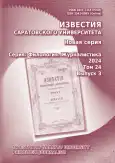The paper examines a complex of figurative meanings of the entomonym “abelha” (“bee”), manifested in the space of the Portuguese poetic text of the 19th–20th centuries. The purpose of the work is to trace the transformation of the image and its semantic increments. We used methods of contextual, stylistic, semantic analysis and linguistic and cultural commentary. The material includes poems by Almeida Garret, Guerra Junqueiro, Antonio Nobre, Fernando Pessoa, Sofi a de Mello, José Saramago, Fernando Echevarría, etc. The bee is one of the few insects that are evaluated mostly positively in the Portuguese language worldview. However, specific individual authors’ figurative associations diff er in their originality, significantly expanding and complementing the corresponding concept. So, a swarm of bees symbolizes both a sensibly organized collective work, and a gang of naughty schoolboys (G. Junqueiro). At the same time, a separate bee, along with diligence in work, is associated with a thirst for life and creativity (S. de Mello), the birth of rhymes swarming in the mind, boiling thoughts (J. Saramago) and the fervor of love (J. Saramago, A. Garret). The fl ight of a bee over blooming gardens is often likened in Portuguese poetry to the craving of a man for a woman, and the bees themselves become an allegory of sparkling glances (E. de Castro), also of lips and kisses – thanks to the association with honey. Sounds’ similes are important as well: they are guitar chords, fado melodies (A. Nobre). The vast variability of poetic interpretations of the bee’s image is cemented into a single whole by the idea of intensity: diligent collective work, ardent love, a passionate desire to live and create (thirst for life), a powerful creative upsurge, irrepressible frolic of children, deep and rich (thick) sounds of fado in silence, the inviting shine of bright eyes. The image of a bee, reinterpreted in Portuguese poems, is distinguished by a variety of associative foundations, originality and versatility. Having undergone significant transformations in poetic discourse, the updated semantic palette of this entomonym enriches the imagery of the Portuguese language.
 242-249
242-249


 250-256
250-256


 257-263
257-263


 264-270
264-270


 271-278
271-278


 279-287
279-287


 288-295
288-295


 296-301
296-301


 302-308
302-308


 309-318
309-318


 319-324
319-324


 325-332
325-332


 333-339
333-339


 340-345
340-345


 346-353
346-353


 354-357
354-357











